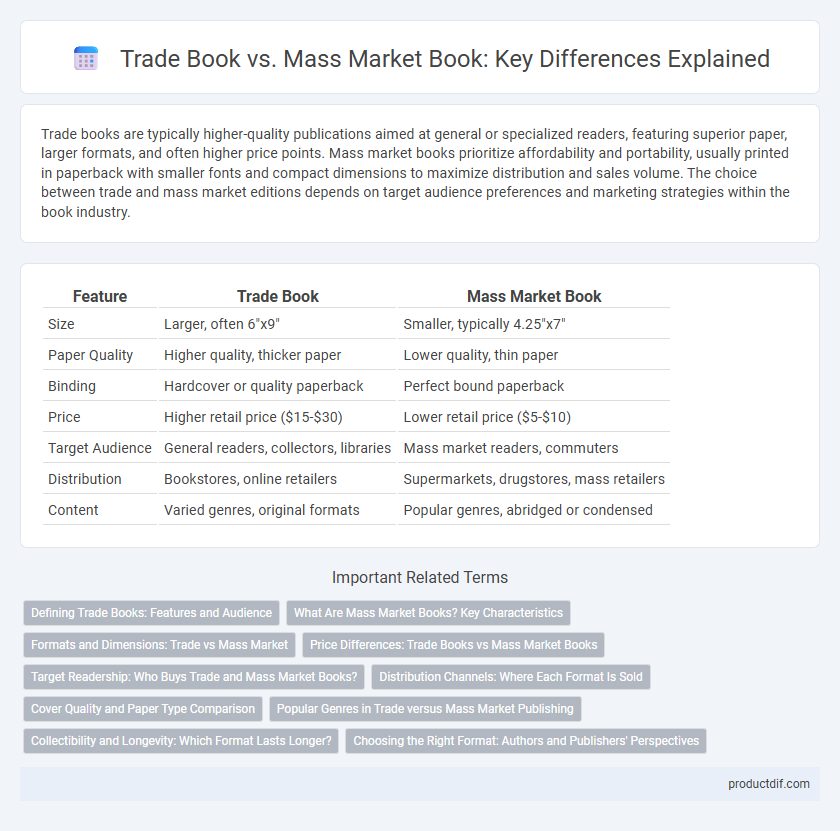Trade books are typically higher-quality publications aimed at general or specialized readers, featuring superior paper, larger formats, and often higher price points. Mass market books prioritize affordability and portability, usually printed in paperback with smaller fonts and compact dimensions to maximize distribution and sales volume. The choice between trade and mass market editions depends on target audience preferences and marketing strategies within the book industry.
Table of Comparison
| Feature | Trade Book | Mass Market Book |
|---|---|---|
| Size | Larger, often 6"x9" | Smaller, typically 4.25"x7" |
| Paper Quality | Higher quality, thicker paper | Lower quality, thin paper |
| Binding | Hardcover or quality paperback | Perfect bound paperback |
| Price | Higher retail price ($15-$30) | Lower retail price ($5-$10) |
| Target Audience | General readers, collectors, libraries | Mass market readers, commuters |
| Distribution | Bookstores, online retailers | Supermarkets, drugstores, mass retailers |
| Content | Varied genres, original formats | Popular genres, abridged or condensed |
Defining Trade Books: Features and Audience
Trade books are typically published for general readership with higher-quality paper, larger formats, and more sophisticated cover designs, distinguishing them from mass market books. These books target readers interested in fiction, nonfiction, and literary works, emphasizing content depth and aesthetic appeal. Trade books prioritize durability and presentation, catering to bookstores and libraries rather than broad, price-sensitive markets.
What Are Mass Market Books? Key Characteristics
Mass market books are small, inexpensive paperback editions designed for wide distribution and affordability. They typically have lower quality paper, smaller fonts, and standardized dimensions around 4.25 x 7 inches, enabling easy portability and mass production. Often found in supermarkets, airports, and drugstores, mass market books usually feature popular fiction genres aimed at casual readers and impulse buyers.
Formats and Dimensions: Trade vs Mass Market
Trade books typically feature larger dimensions, usually around 6 x 9 inches, providing more spacious layouts suitable for detailed illustrations and higher-quality paper. Mass market books are smaller, approximately 4.25 x 7 inches, designed for portability and cost efficiency, often printed on lower-quality paper. The format difference reflects distinct market strategies: trade books target readers seeking durability and aesthetic appeal, while mass market books prioritize affordability and mass distribution.
Price Differences: Trade Books vs Mass Market Books
Trade books typically have higher price points ranging from $15 to $30 due to superior print quality, larger trim sizes, and hardcover options compared to mass market books. Mass market books are priced between $5 and $10, targeting budget-conscious readers with smaller formats and cheaper paper quality. The price difference reflects production costs, distribution channels, and target demographics, with trade books aimed at libraries and collectors while mass market editions prioritize accessibility and affordability.
Target Readership: Who Buys Trade and Mass Market Books?
Trade books primarily attract adult readers interested in fiction, non-fiction, and literary works often sold in bookstores and online. Mass market books target a broader audience, including casual readers who prefer affordable, portable editions mostly found in supermarkets, airports, and drugstores. The distinction reflects different buying habits: collectors and enthusiasts favor trade books, while mass market editions appeal to budget-conscious consumers seeking popular genres.
Distribution Channels: Where Each Format Is Sold
Trade books are primarily distributed through bookstores, online retailers, and libraries, catering to readers who prefer higher-quality printing and a broader range of genres. Mass market books are widely available in supermarkets, drugstores, convenience stores, and airports, targeting a broader, price-sensitive audience with affordable pricing and compact formats. Both formats utilize distinct distribution channels to maximize reach according to the preferences and buying habits of their respective readers.
Cover Quality and Paper Type Comparison
Trade books feature higher cover quality with durable, often laminated hardbacks or sturdy paperbacks, enhancing longevity and aesthetic appeal. Mass market books use thinner, lower-quality paper and flexible, glossy soft covers designed for cost-effective mass production and portability. The superior paper type in trade books improves print clarity and durability compared to the lightweight, absorbent paper typical of mass market editions.
Popular Genres in Trade versus Mass Market Publishing
Trade books often dominate genres such as literary fiction, biography, and high-quality nonfiction, appealing to adult readers seeking depth and unique storytelling. Mass market books primarily focus on popular genres like romance, thriller, and science fiction, offering affordable, widely accessible editions for a broad audience. Genre preferences distinctly influence production and marketing strategies within trade and mass market publishing sectors.
Collectibility and Longevity: Which Format Lasts Longer?
Trade books, often printed on higher-quality paper with better binding, offer superior durability and are more collectible compared to mass market books, which use cheaper materials and glue binding that degrade faster. Collectors favor trade books for their aesthetic appeal, longevity, and potential to retain value over time. Mass market books, designed for short-term, affordable reading, typically deteriorate quickly, reducing their long-term appeal and collectibility.
Choosing the Right Format: Authors and Publishers' Perspectives
Trade books typically offer higher quality paper, larger trim sizes, and more durable bindings, appealing to readers seeking a premium reading experience, while mass market books prioritize affordability and portability with smaller dimensions and lower production costs. Authors often prefer trade books for enhanced presentation and better royalty rates, whereas publishers weigh market reach and cost-efficiency when deciding to produce mass market editions. Choosing the right format involves balancing target audience preferences, distribution channels, and financial considerations to maximize a book's success.
Trade Book vs Mass Market Book Infographic

 productdif.com
productdif.com